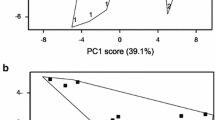Abstract
Metabolic profiling methods are not ideally suited to the simultaneous analysis of all metabolite classes within a biological sample and must be optimized for maximum applicability. Several factors related to the optimization, validation and limitations of a GC–MS-based metabolic profiling method for potato were examined. A key step is conversion of reducing sugars to methyloximes, and optimum reaction conditions were 50 °C for 4 h. Shorter times or lower temperatures resulted in incomplete oximation whereas longer times and higher temperatures caused hydrolysis of sucrose, the major tuber dissacharide. Metabolite concentration gradients were observed in tuber sections. Glucose, fructose, alanine, methionine, threonine and tyrosine were more concentrated in the interior, whereas asparagine, putrescine, and caffeic and chlorogenic acids were higher in the skin and citrate was concentrated at the tuber’s bud end. These results impact upon choice of sampling strategy, consequently the use of freeze-dried (FD) material from a sampling protocol developed to avoid gradient-induced bias was examined. Using FD material, the method was highly linear and there was little qualitative or quantitative difference in the metabolite composition between fresh and FD material. The short- and long-term repeatability of the method was studied, and the use of reference materials to monitor and to improve data quality is discussed. Ascorbate is an important tuber metabolite that is readily measured by targeted approaches, but can be a problem in metabolic profiling. It was shown for standards and FD potato that ascorbate was largely degraded during oximation, although some survived in FD material.





Similar content being viewed by others
References
Brown J., Mackay G.R., Bain H., Griffiths D.W., Allison M.J. (1990) The processing potential of tubers of the cultivated potato, Solanum tuberosum L., after storage at low temperatures. 2. Sugar concentration. Potato Res. 33:219–227
Cellini F., Chesson A., Colquhoun I., Constable A., Davies H.V., Engel K.H., Gatehouse A.M., Karenlampi S., Kok E.J., Leguay J.J., Lehesranta S., Noteborn H.P., Pedersen J., Smith M. (2004) Unintended effects and their detection in genetically modified crops. Food & Chem. Toxicol. 42: 1089–1125
Davey M.W., Van Montagu M., Inzé D., Sanmartin M., Kanellis A., Smirnoff N., Benzie I.J.J., Strain J.J., Favell D., Fletcher J. (2000) Plant l-ascorbic acid: chemistry, function, metabolism, bioavailability and effects of processing. J. Sci. Food Agric. 80: 825–860
Dale M.F.B., Griffiths D.W., Todd D.T. (2003) Effects of genotype, environment, and postharvest storage on the total ascorbate content of potato (Solanum tuberosum) tubers. J. Agric. Food Chem. 51: 244–248
Deutsch J.C. (1998a) Ascorbic acid oxidation by hydrogen peroxide. Anal. Biochem. 255: 1–7
Deutsch J.C. (1998b) Spontaneous hydrolysis and dehydration of dehydroascorbic acid in aqueous solution. Anal. Biochem. 260: 223–229
Deutsch J.C. (1998c) Oxygen-accepting antioxidants which arise during ascorbate oxidation. Anal. Biochem. 265:238–245
FAOSTAT (2005). Food and agriculture organization of the United Nations. FAO statistical databases. http://faostat.fao.org.
Frenzel T., Miller A., Engel K.H. (2002) Metabolite profiling – a fractionation method for analysis of major and minor compounds in rice grains. Cereal Chem. 79:215–221
Goodpaster J.V. (2004) Identification of ascorbic acid and its degradation products in black powder substitutes. J. Forensic Sci. 49: 1–6
Griffiths D.W., Dale M.F.B. (2001) Effect of light exposure on the glycoalkaloid content of Solanum phureja tubers. J. Agric. Food Chem. 49: 5223–5227
Hughes J.C., Swain T. (1962). After-cooking blackening in potatoes. II.-Core experiments. J. Sci. Food Agric. 13: 229–236
Jung C.-H., Wells W.W. (1998) Spontaneous conversion of l-dehydroascorbic acid to l-ascorbic acid and l-erythroascorbic acid. Arch. Biochem. Biophys. 355: 9–14
Lehesranta S.J., Davies H.V., Shepherd L.V., Nunan N., McNicol J.W., Auriola S., Koistinen K.M., Suomalainen S., Kokko H.I., Karenlampi S.O. (2005) Comparison of tuber proteomes of potato varieties, landraces, and genetically modified lines. Plant Physiol. 138: 1690–1699
Merlo L., Geigenberger P., Hajirezaei M., Stitt M. (1993) Changes of carbohydrates, metabolites and enzyme activities in potato tubers during development, and within a single tuber along a stolon-apex gradient. J. Plant Physiol. 142: 392–402
Nishikawa Y., Kurata T. (2000). Interconversion between dehydro-l-ascorbic acid and l-ascorbic acid. Biosci. Biotechnol. Biochem. 64: 476–483
Roessner U., Wagner C., Kopka J., Trethewey R.N., Willmitzer L. (2000) Simultaneous analysis of metabolites in potato tuber by gas chromatography–mass spectrometry. Plant J. 23: 131–142
Roessner U., Luedemann A., Brust D., Fiehn O., Linke T., Willmitzer L., Fernie A.R. (2001) Metabolic profiling allows comprehensive phenotyping of genetically or environmentally modified plant systems. Plant Cell 13: 11–29
Schauer N., Steinhauser D., Strelkov S., Schomburg D., Allison G., Moritz T., Lundgren K., Roessner-Tunali U., Forbes M.G., Willmitzer L., Fernie A.R., Kopka J. (2005b) GC–MS libraries for the rapid identification of metabolites in complex biological samples. FEBS Lett. 579:1132–1137
Schauer N., Zamir D., Fernie A.R. (2005b) Metabolic profiling of leaves and fruit of wild species tomato: a survey of the Solanum lycopersicum complex. J. Exp. Bot. 56: 297–307
Scott G.J., Rosegrant M.W., Ringler C. (2000) Global projections for root and tuber crops to the year 2020. Food Policy 25: 561–597
Urbanczyk-Wochniak E., Fernie A.R. (2005) Metabolic profiling reveals altered nitrogen nutrient regimes have diverse effects on the metabolism of hydroponically-grown tomato (Solanum lycopersicum). J. Exp. Bot. 56: 309–321
Urbanczyk-Wochniak E., Baxter C., Kolbe A., Kopka J., Sweetlove L.J., Fernie A.R. (2005) Profiling of diurnal patterns of metabolite and transcript abundance in potato (Solanum tuberosum) leaves. Planta 221:891–903
Acknowledgements
The authors acknowledge the support of the Scottish Executive Environment and Rural Affairs department.
Author information
Authors and Affiliations
Corresponding author
Electronic supplementary material
Below is the link to the electronic supplementary material
Rights and permissions
About this article
Cite this article
Shepherd, T., Dobson, G., Verrall, S.R. et al. Potato metabolomics by GC–MS: what are the limiting factors?. Metabolomics 3, 475–488 (2007). https://doi.org/10.1007/s11306-007-0058-2
Received:
Accepted:
Published:
Issue Date:
DOI: https://doi.org/10.1007/s11306-007-0058-2




